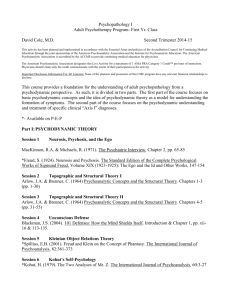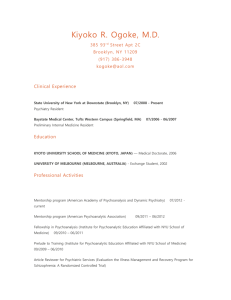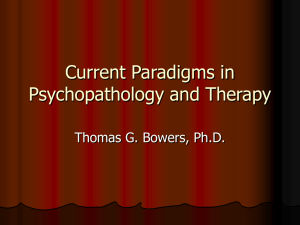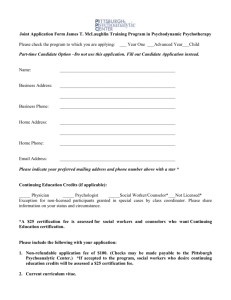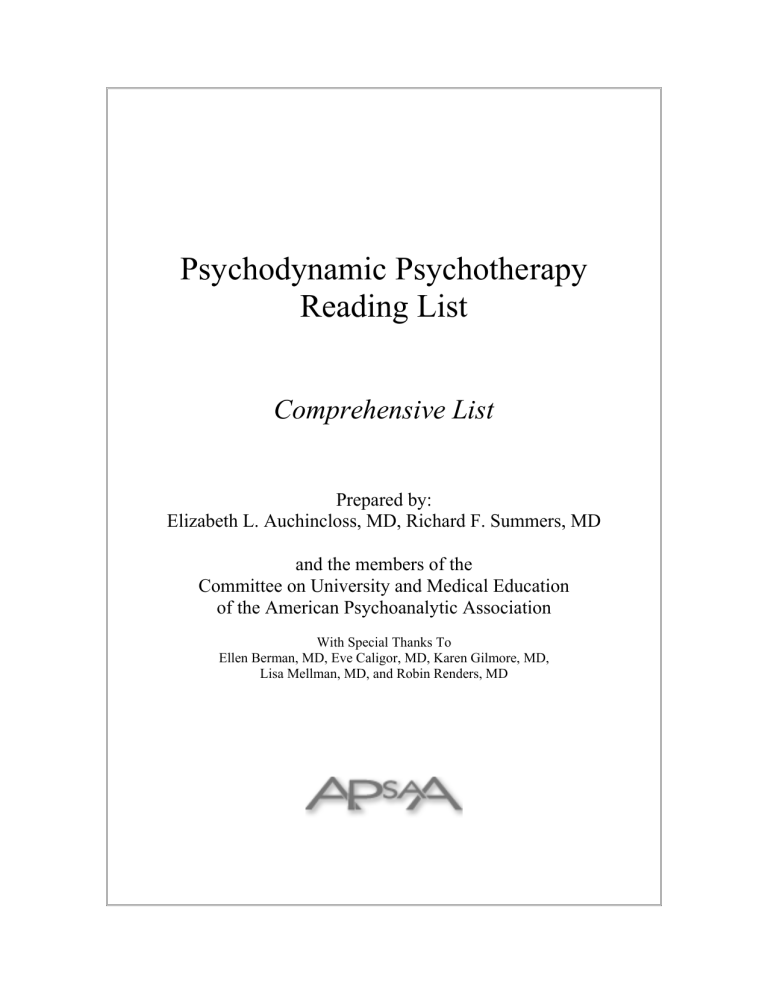
Psychodynamic Psychotherapy Reading List Comprehensive List Prepared by: Elizabeth L. Auchincloss, MD, Richard F. Summers, MD and the members of the Committee on University and Medical Education of the American Psychoanalytic Association With Special Thanks To Ellen Berman, MD, Eve Caligor, MD, Karen Gilmore, MD, Lisa Mellman, MD, and Robin Renders, MD TABLE OF CONTENTS: I. CORE TEXTS 4 II. HISTORY 4 III. BASIC PRINCIPLES 4 IV. THEORY OF MIND 5 A. The topographic model of the mind and the dynamic unconscious B. Fantasy and psychic reality: conscious and unconscious C. Structural theory and ego psychology D. The id: psychosexuality, libido theory, the drives, aggression E. The superego and the ego ideal F. Ego, conflict, defense, compromise G. Object relations theory H. Self psychology V. DEVELOPMENT 7 A. Core texts and overview B. Infancy C. Attachment theory D. The development of the self E. Object relations F. Separation individuation and transitional phenomena G. Object constancy H. Gender development I. Oedipus complex J. Play K. Latency L. Puberty and adolescence M. Homosexuality N. Post-adolescent development O. Parenthood and pregnancy P. Midlife and aging VI. PSYCHOPATHOLOGY 12 A. Core Texts B. Core concepts: neurosis and character C. Severe personality disorders D. Pathological narcissism, narcissistic personality and antisocial personality 2 E. Masochism and masochistic personality F. Hysterical and histrionic personality and dissociative disorders G. Obsessional personality H. Anxiety and depression I. Trauma and loss J. Paraphilias, substance abuse, eating disorders K. Psychosis VII. ASSESSMENT: INTERVIEWING AND FORMULATION VIII. TREATMENT A. B. C. D. E. F. G. H. I. J. K. L. 16 16 Core texts Engagement and resistance Recognizing and working with transference and countertransference Interventions: questions, clarifications, interpretations Working with fantasy, dreams Therapeutic relationship Boundaries and mistakes Middle phase and working through, mechanisms of change Termination The suicidal patient The experience of being a therapist Relationship to other psychotherapies i. CBT ii. Psychoanalysis iii. Couples/family/systems iv. Psychopharmacology IX. THE PSYCHOTHERAPY EXPERIENCE: CASE DESCRIPTIONS 20 X. CLASSIC FREUD PAPERS 21 XI. NEW DIRECTIONS 21 A. Cognitive neuroscience B. Evidence base for psychodynamic psychotherapy 3 I. CORE TEXTS Gabbard, G.O. (2000) Psychodynamic Psychiatry in Clinical Practice, Third edition, Washington, D.C.: American Psychiatric Press. Gabbard, G.O. (2004) Long-Term Psychodynamic Psychotherapy: A Basic Text, Washington, DC: American Psychiatric Press. McWilliams, N. (1999) Psychoanalytic Case Formulation, New York: The Guilford Press, Inc. McWilliams, N. (2004) Psychoanalytic Psychotherapy, New York: Guilford Press. Mitchell, S.A., Black, M.J. (1995) Freud and Beyond: A History of Modern Psychoanalytic Thought, New York: Basic Books. Moore, B.E. (1995) Psychoanalysis: The Major Concepts, New Haven, Yale University Press. Moore, B.E., Fine, B.R., eds. (1990) Psychoanalytic Terms and Concepts, New Haven: Yale University Press. Schwartz, H., et al., eds. (1995) Psychodynamic Concepts in General Psychiatry, Washington, D.C.: American Psychiatric Press. II. HISTORY Eagle, M. (2000) “Psychoanalysis: History of the Field,” in Encyclopedia of Psychology, ed. A. Kazdin, New York: Oxford University Press. Gay, P. (1988). Freud: A Life for Our Time, New York: W. W. Norton & Co. Jones, E. (1961) The Life and Work of Sigmund Freud, ed. L. Trilling & S. Marcus, New York: Basic Books, Harper. III. BASIC PRINCIPLES “Psychoanalysis, psychodynamics, psychic determinism,” (1990) in Psychoanalytic Terms and Concepts, eds. Moore, B.E, Fine, B.R., New Haven: Yale University Press. Auchincloss, E.L., Glick, R.A. (1998) “The psychoanalytic model of the mind,” in Psychiatry, ch. 1, ed. R. Michels, Philadelphia: Lippincott. 4 Cooper, A. (1985) An historical review of psychoanalytic paradigms, in Models of the Mind, ed. A. Rothstein, Madison CT, International Universities Press, pp. 5-20. Gabbard, G.O. (2000) Psychodynamic Psychiatry in Clinical Practice, Third edition, Washington, D.C. American Psychiatric Press, ch. 1-2. Michels, R. (1995) Basic principles of psychodynamic psychiatry in Psychodynamic Concepts in General Psychiatry, ed. Schwartz, H., et al, Washington D.C.: American Psychiatric Press, pp. 3-12. Westen, D. (2000) Psychoanalysis: theories, in Encyclopedia of Psychology, ed. A. Kazdin, New York: Oxford University Press. IV. THEORY OF MIND A. The topographic model of the mind and the dynamic unconscious “Unconscious, Topographic point of view,” (1990) in Psychoanalytic Terms and Concepts, eds. Moore, B.E, Fine, B.R., New Haven: Yale University Press. Arlow, J., Brenner, C. (1964) Psychoanalytic Concepts and Structural Theory, New York: International Universities Press, ch. 2-3. B. Fantasy and psychic reality: conscious and unconscious “Fantasy, Psychic reality,” (1990) in Psychoanalytic Terms and Concepts, eds. Moore, B.E, Fine, B.R., New Haven: Yale University Press. Arlow, J. (1995) Unconscious fantasy, in Psychoanalysis : The Major Concepts, eds. Moore, B.E., Fine, B.R., New Haven: Yale University Press. Arlow, J. (1969) Unconscious fantasy and disturbances of mental experience, Psychoanalytic Quarterly, 38:1-27. Fonagy, P., Target, M. (1996) Playing with reality: I Theory of mind and the normal development of psychic reality, International J. Psychoanalysis, 77:217-233. Person, E. (1995) By Force of Fantasy, New York City: Penguin, ch. 1-2. C. Structural Theory and Ego Psychology “Structure, Structural theory,” (1990) in Psychoanalytic Terms and Concepts, eds. Moore, B.E, Fine, B.R., New Haven: Yale University Press. Arlow, J., Brenner, C. (1964) Psychoanalytic Concepts and Structural Theory, New York: International Universities Press, ch. 4-5. 5 Boesky, D. (1995) Structural theory, in Psychoanalysis : The Major Concepts, eds. Moore, B.E., Fine, B.R., New Haven: Yale University Press. D. The id: psychosexuality. libido theory, the drives, aggression “Aggression, Instinctual drive, Infantile sexuality, Id, Psychosexual development, Libido theory,” (1990) in Psychoanalytic Terms and Concepts, eds. Moore, B.E, Fine, B.R., New Haven: Yale University Press. Mayes, L., Cohen, D. (1993) The social matrix of aggression: enactments and representations of loving and hating in the first years of life, Psychoanalytic Study of the Child, 48:145-169. Ritvo, S., Solnit, A. (1995) Instinct Theory, in Psychoanalysis : The Major Concepts, eds. Moore, B.E., Fine, B.R., New Haven, Yale University Press. Wiedeman, G. (1995) Sexuality, in Psychoanalysis : The Major Concepts, eds. Moore, B.E., Fine, B.R. New Haven: Yale University Press. E. The superego and the ego ideal “Superego, Ego ideal,” (1990) in Psychoanalytic Terms and Concepts, eds. Moore, B.E, Fine, B.R., New Haven: Yale University Press. Brenner, C. (1955) An Elementary Textbook of Psychoanalysis, New York: International Universities Press. F. Ego, conflict, defense, compromise “Ego, Ego function, Conflict, Defense, Compromise formation,” (1990) in Psychoanalytic Terms and Concepts, eds. Moore, B.E, Fine, B.R., New Haven: Yale University Press. Beres, D. (1995) Conflict, in Psychoanalysis : The Major Concepts, eds. Moore, B.E., Fine, B.R., New Haven: Yale University Press. Brenner, C. (1976) Psychic conflict and the task of the analyst, in Psychoanalytic Technique and Psychic Conflict, New York: International Universities Press, ch. 1. Cooper, S.H. (1992) The empirical study of defensive processes: A review, in The Interface of Psychoanalysis and Psychology, eds. Barron, J.W., et al, Washington D.C.: American Psychological Association. Willick, M. (1995) Defense, in Psychoanalysis : The Major Concepts, eds. Moore, B.E., Fine, B.R., New Haven: Yale University Press. 6 G. Object relations theory “Object, Object constancy, Object relations theory, Representational world,” (1990) in Psychoanalytic Terms and Concepts, eds. Moore, B.E, Fine, B.R., New Haven: Yale University Press. Greenberg, J., Mitchells, S. (1983) Object relations and psychoanalytic models, in Object Relations in Psychoanalysis, Cambridge: Harvard Univ. Press, 1983, pp 9-20. Kernberg, O. (1995) Psychoanalytic object relations theories, in Psychoanalysis: The Major Concepts, eds. Moore, B.E., Fine, B.R., New Haven: Yale University Press. H. Self psychology “Self, Self psychology” (1990) in Psychoanalytic Terms and Concepts, eds. Moore, B.E, Fine, B.R., New Haven: Yale University Press. Lichtenberg, J., Wolf, E. (1997) General principles of self psychology: a position statement, Journal of the American Psychoanalytic Association, 45:531-544. Spruiell, V. (1995) Self, in Psychoanalysis : The Major Concepts, eds. Moore, B.E., Fine, B.R., New Haven: Yale University Press. V. DEVELOPMENT A. Core texts and overview “Development,” (1990) in Psychoanalytic Terms and Concepts, eds. Moore, B.E, Fine, B.R., New Haven: Yale University Press. Fraiberg, S.H. (1996) The Magic Years, New York: Scribner. Greenspan, S., Pollock, G. eds. (1989, 1990) The Course of Life, 2nd edition, Madison, CT: International Universities Press. Volume I: Infancy, Volume II: Early Childhood, Volume III: Childhood, Volume IV: Adolescence, Volume V: Adulthood and the Aging Process. Tyson, P., Tyson, R. (1995) Development, in Psychoanalysis : The Major Concepts, eds. Moore, B.E., Fine, B.R., New Haven, Yale University Press, 1995. Tyson, P., Tyson, R. (1990) Psychoanalytic Theories of Development: An Integration, New Haven: Yale University Press , ch.1-2. B. Infancy 7 Emde, R. (1988) Development Terminable and Interminable I. Innate and Motivational Factors From Infancy, International J. Psychoanalysis , 69:23-42. Stern, D. (1985) The interpersonal world of the infant, New York: Basic Books. C. Attachment theory Ainsworth, M., Blehar, M., Water, E., Wall, S. (1978) Patterns of Attachment: A Psychological Study of the Strange Situation, Hillsdale, NJ: Erlbaum. Bowlby, F. (1958) The nature of the child's tie to his mother, International Journal of Psychoanalysis, 39:350-373. Fonagy, P. (2001) Summary: What do Psychoanalytic Theories and Attachment Theory Have in Common? Chapter 12 in Attachment Theory and Psychoanalysis, New York: Other Press, pp.157-184. Main, M. (1993) Discourse, prediction and recent studies in attachment: implications for psychoanalysis, Journal of the American Psychoanalytic Association, 41:209-244. Slade, A. (2000) The development and organization of attachment: implications for psychoanalysis, Journal of the American Psychoanalytic Association, 48: 1147-1174. D. The development of the self Beebe, B. (1988) The contribution of mother-infant influence to the origin of self and object representations, Psychoanalytic Psychology, 5:305-337. Pine, F. (1982) The experience of self-aspects of its formation, expansion, and vulnerability, Psychoanalytic Study of the Child, 37: 143-167. Stern, D. (1989) Developmental Prerequisites for the Sense of a Narrated Self, in Psychoanalysis Toward the Second Century, eds. Cooper, A., et al., New Haven: Yale University Press, pp.168-180. E. Object relations Kernberg, O. (1976) Normal and Pathological Development, in Object Relations Theory and Clinical Psychoanalysis, New York: Jason Aronson, Inc., ch. 2. Gilligan, C., et al. (1988) The origins of morality in early childhood relationships, in Mapping the moral domain, ed. C. Gilligan, Cambridge: Harvard University Press. F. Separation individuation and transitional phenomena 8 Mahler, M. (1972) On The First Three Subphases of the Separation-Individuation Process, International Journal of Psychoanalysis, 53:333-338. Winnicott, D. (1953) Transitional objects and transitional phenomenon: A study of the first not-me possession, International Journal of Psychoanalysis, 34:89-97. G. Object constancy Akhtar, S. (1994) Object Constancy and Adult Psychopathology, International Journal of Psychoanalysis, 75: 441-455. Fraiberg, S. (1969) Libidinal Object Constancy and Mental Representation. Psychoanalytic Study of the Child, 24:9-47. McDevitt, J. B. (1975) Separation-Individuation and Object Constancy, Journal of the American Psychoanalytic Association, 23:713-742. Pine, F. (2004) Mahler’s concepts of symbiosis and separation-individuation: revisited, reevaluated, refined, Journal of the American Psychoanalytic Association, 52:511-533. H.Gender development Dorsey, D. (1996) Castration Anxiety Or Feminine Genital Anxiety? Journal of the American Psychoanalytic Association, 44(S):283-302. Fast, I. (1990). Aspects of early gender development: toward a reformulation, Psychoanalytic Psychology, (suppl)7, 105-117. Lerner, H.E. (1976). Parental Mislabeling of Female Genitals as a Determinant of Penis Envy and Learning Inhibitions in Women, Journal of the American Psychoanalytic Association, 248:269-283. Olesker, W. (1998). Female Genital Anxieties: Views from the Nursery and the Couch. Psychoanalytic Quarterly, 67:276-294. I. The oedipus complex Cohen, D., et al. (1987). Analytic Discussions with Oedipal Children, Psychoanalytic Study of the Child, 42: 59-83. Parens, H., et al. (1976) On The Girl's Entry Into The Oedipus Complex, Journal of the American Psychoanalytic Association, 24:79-107. Parens, H. (1990) On the girl’s psychosexual development: reconsiderations from direct observation, Journal of the American Psychoanalytic Association, 38: 743-772. 9 J. Play Slade, A. (1994) Making meaning and making believe: their role in the clinical process. in Children at Play, ed. A. Slade and D. Wolff. New York: Oxford University Press. Birch, M. (1997). In the land of counterpane: Travels in the realm of play, Psychoanalytic Study of the Child, 52:57-75. Solnit, A. (1987) A psychoanalytic view of play, Psychoanalytic Study of the Child, 42: 205-219. K. Latency Novick, K.K., Novick, J. (1994) Postoedipal transformations: Latency, Adolescence and pathogenesis, Journal of the American Psychoanalytic Association, 42:143-169. Shapiro, T., Perry, R. (1976) Latency Revisited: The age seven plus or minus one, Psychoanalytic Study of the Child, 31:79-107. Sarnoff, C. (1976) The structure of latency, in Latency, Aronson Press, pp. 13-36. Friedman, R., Downey, J. (2000) The Psychobiology of Late Childhood: Significance for psychoanalytic developmental theory and clinical practice, J. Am Academy. of Psychoanalysis, 28(3):431-448. L. Puberty and adolescence Blos, P. (1967). The second individuation process in adolescence, Psychoanalytic Study of the Child, 22: 162-186. Blos, P. (1967). The concept of acting out in relation to the adolescent process, in The Adolescent Passage: Developmental Issues, New York: International Universities Press, pp. 254-277. Chused, J. (1990). Neutrality in the analysis of action-prone adolescents, Journal of the American Psychoanalytic Association. 38: 679-704. Doctors, S. (2000) Attachment-Individuation: 1. Clinical notes toward a reconsideration of adolescent turmoil, Adolescent Psychiatry, 25: 3-17. Freud, A. (1936) Instinctual anxiety during puberty, in The Psychology of Adolescence: Essential Readings, ed. Esman, A., New York: International Universities Press, pp. 109121. Offer, D., Schonert-Reichl, K. (1992) Debunking the myths of adolescence: findings from recent research, Journal of the American Academy of Child and Adolescent Psychiatry, 31(6):1003-1014. 10 Ritvo, S. (1971) Late adolescence: developmental and clinical considerations. Psychoanalytic Study of the Child 26: 241-263. Settlage, C. (1972). Cultural values and the superego in late adolescence, Psychoanalytic Study of the Child, 27: 74-92. M. Homosexuality Isay, R. (1989) Being Homosexual: Gay Men and their Development, New York: Farrar, Straus and Giroux. Vaughan, S. (1998) Psychoanalytic and biological perspectives on lesbian patients: Why developmental themes are more important in psychotherapy, Harvard Review of Psychiatry, 6(3): 160-164. See also web link to the American Psychoanalytic Association Committee on Gay and Lesbian Issues bibliography, http://www.apsa.org/ctf/cgli/bibliography.htm. N. Post-adolescent development Blos, P. (1972) The Epigenesis of the Adult Neurosis, Psychoanalytic Study of the Child, 27:106-135. Chused, J. (1987) Idealization of the Analyst by the Young Adult, Journal of the American Psychoanalytic Association, 35:839-859. Colarusso, C. (1995) Transversing young adulthood: the male journey from 20 to 40. Psychoanalytic Inquiry, 15: 75-91. O. Parenthood and pregnancy Novick, K.K. (1988) Childbearing and child rearing, Psychoanalytic Inquiry, 8: 252-260. Slade, A., Cohen, L. (1996) Parenting and the remembrance of things past, Infant Mental Health Journal, 17:217-239. Winnicott, D. W. (1960) The Theory of the Parent-Infant Relationship, Int. J. PsychoAnalysis, 41:585-595. P. Midlife and aging: Erickson, E. (1986) Childhood and Society, New York: W.W. Norton & Co. Jacques, E. (1981) The midlife crisis, in The Course of Life, 2nd edition, eds. Greenspan, S., Pollock, G., Madison, CT: International Universities Press. 11 Levinson, D.J., et al. (1978) The Seasons of a Man’s Life, New York: Alfred A. Knopf and Sons. Levinson, D.J. (1996) The Seasons of a Woman’s Life, New York: Ballantine Books. Vaillant, G. (1995) Adaptation to Life, Cambridge, MA: Harvard University Press. VI. PSYCHOPATHOLOGY A. Core texts Ahktar, S. (1992) Broken Structures: Severe personality disorders and their treatment, New Jersey, Jason Aronson. Gabbard, G.O. (2000) Psychodynamic Psychiatry in Clinical Practice, Third edition, Washington, D.C.: American Psychiatric Press. MacKinnon, R., Michels, R. (1971) The Psychiatric Interview in Clinical Practice, Philadelphia: W.B. Saunders. McWilliams, N. (1999) Psychoanalytic Case Formulation, New York: The Guilford Press, Inc., pp. 200-209. Schwartz, H., et al. (1995) Psychodynamic Concepts in General Psychiatry, Washington D.C.: American Psychiatric Press. Shapiro, D. (1965) Neurotic Styles, New York: Basic Books. B. Core concepts: Neurosis and character “Neurosis, Psychoneurosis, Character, Personality” (1990) in Psychoanalytic Terms and Concepts, eds. Moore, B.E, Fine, B.R., New Haven: Yale University Press. Auchincloss, B.A., Michels, R. (1983) Psychoanalytic theory of character, in Current Perspectives on Personality Disorders, ed. J.P. Frosch, Washington, D.C.: American Psychiatric Press, pp. 2-19. Kernberg, O. (1970) A psychoanalytic classification of character pathology, Journal of the American Psychoanalytic Association, 18: 800-822. Pulver, S. (1995) Symptomatology, in Psychoanalysis : The Major Concepts, New Haven, Yale University Press, pp. 186-195. C. Severe personality disorders 12 Ahktar, S. (1992) Paranoid personality disorder, in Broken Structures: Severe Personality Disorders and Their Treatment, New Jersey: Jason Aronson, ch. 6, pp. 151-176. Gabbard, G.O. (2000) Cluster A Personality Disorders: Paranoid, Schizoid, and Schizotypal, in Psychodynamic Psychiatry in Clinical Practice, Third edition, Washington, D.C.: American Psychiatric Press, pp. 385-410. Gabbard, G.O. (2000) Personality disorders: Borderline, in Psychodynamic Psychiatry in Clinical Practice, Third edition, Washington, D.C.: American Psychiatric Press, pp. 410462. Goldstein, W. (1988) Kernberg on the borderline: a simplified version, in New Concepts in Psychoanalytic Psychotherapy, eds., J.M. Ross, W. Meyers, Washington, DC: American Psychiatric Press, ch. 10, pp. 168-186. Gunderson, J. (2000) “Psychodynamic Psychotherapy for Borderline Personality Disorder,” in Psychotherapy for Personality Disorders, eds. Gunderson, J.G., Gabbard, G.O., Washington, DC: American Psychiatric Press. Kernberg, O. (1975) Borderline Conditions and Pathological Narcissism, New York: Jason Aronson. Shapiro, D. (1965) Paranoid style, in Neurotic Styles, New York: Basic Books, pp.54-107 D. Pathological narcissism, narcissistic personality and antisocial personality: Akhtar, S. (1992) Narcissistic personality disorder, in Broken Structures: Severe Personality Disorders and Their Treatment, New Jersey: Jason Aronson, pp . 45-78. Gabbard, G.O. (2000) Personality disorders: Antisocial, in Psychodynamic Psychiatry in Clinical Practice, Third edition, Washington, D.C.: American Psychiatric Press, pp. 491516. Gabbard, G.O. (2000) Personality disorders: Narcissistic, in Psychodynamic Psychiatry in Clinical Practice, Third edition, Washington, D.C.: American Psychiatric Press, pp. 462-490. Kernberg, O. (1970) Factors in the psychoanalytic treatment of narcissistic personalities, Journal of the American Psychoanalytic Association, 18:51-85. Kernberg, O (1975) Normal and pathological narcissism, in Borderline Conditions and Pathological Narcissism, New York: Jason Aronson, pp.315-346. Kernberg, O (1992) Antisocial and narcissistic personality disorders, in Aggression in Personality Disorders and Perversion, New Haven: Yale University Press, ch. 5, pp. 6784. 13 E. Masochism and masochistic personality Brenner, C. (1954) The masochistic character: genesis and treatment, Journal of American Psychoanalytic Association, 7:197-226. Cooper, A. (1973) Narcissistic masochistic character, in The Quiet Revolution in Psychoanalysis: Selected Papers of Arnold M. Cooper, ed. Auchincloss, E.L., London: Rutledge, 2004, pp.121-139. Kernberg, O. (1988) Clinical dimensions of masochism, in Aggression in Personality Disorders and Perversion, New Haven: Yale University Press, pp. 34-51. F. Hysterical and histrionic personality and dissociative disorders Ahktar, S. (1992) Histrionic personality, in Broken Structures: Severe Personality Disorders and Their Treatment, New Jersey: Jason Aronson, 249-260. Gabbard, G.O. (2000) Personality disorders: Hysterical and histrionic, in Psychodynamic Psychiatry in Clinical Practice, Third edition, Washington, D.C.: American Psychiatric Press, pp. 517-546. Gabbard, G.O. (2000) Dissociative disorders, in Psychodynamic Psychiatry in Clinical Practice, Third edition, Washington, D.C.: American Psychiatric Press, pp. 267-298. Kernberg, O. (1990) Hysterical and histrionic personality disorders, in Aggression in Personality Disorders and Perversion, New Haven: Yale University Press, pp. 51-66. MacKinnon, R., Michels, R. (1971) The hysterical patient, in The Psychiatric Interview in Clinical Practice, Philadelphia: W.B. Saunders, pp. 110-146. Shapiro, D. (1965) Hysterical Style, in Neurotic Styles, New York: Basic Books, 108133. G. Obsessional personality Gabbard, G.O. (2000) Personality disorders :Obsessive-Compulsive, Avoidant, and Dependent, in Psychodynamic Psychiatry in Clinical Practice, Third edition, Washington, D.C.: American Psychiatric Press. MacKinnon, R., Michels, R. (1971) The obsessive patient, in The Psychiatric Interview in Clinical Practice, Philadelphia: W.B. Saunders, pp. 89-109. Shapiro, D. (1965) Obsessive style, in Neurotic Styles, New York: Basic Books, pp. 2353. 14 H. Anxiety and depression Bush, F.N., Ruden, M., Shapiro, T. (2004) Psychodynamic Treatment of Depression, Washington, DC: American Psychiatric Press. Freud, S. (1915) Mourning and Melancholia, Standard Edition VXIV: 243-258., ed. J. Strachey, London: W.W. Norton. Gabbard, G.O. (2000) Affective Disorders, in Psychodynamic Psychiatry in Clinical Practice, Third edition, Washington, D.C.: American Psychiatric Press, pp. 203-232. Gabbard, G.O. (2000) Anxiety Disorders, in Psychodynamic Psychiatry in Clinical Practice, Third edition, Washington, D.C.: American Psychiatric Press, pp. 233-266. Milrod, B., Busch, F.N., Cooper A., Shapiro, T. (1997) Manual of Panic-Focused Psychodynamic Psychotherapy, Washington DC: American Psychiatric Press. I. Trauma and Loss Blacher, R. (1995) The Bereaved Patient, in Psychodynamic Concepts in General Psychiatry, ed. Schwartz, H., et al., Washington D.C., American Psychiatric Press, pp. 359-370. Herman, J. (1997) Trauma and Recovery, New York: Basic Books, pp. 7-32, 133-154. Lindy, J. et al. (1995) The Posttraumatic Patient in Psychodynamic Concepts in General Psychiatry, ed. Schwartz, H., et al., Washington D.C.: American Psychiatric Press, pp. 263-278. Levine, H. (1995) The Patient with a History of Childhood Sexual Abuse or Incest, Psychodynamic Concepts in General Psychiatry, ed. Schwartz, H., et al., Washington D.C.: American Psychiatric Press, pp. 297-312. J. Paraphilias, Substance Abuse, Eating Disorders Gabbard, G.O. (2000) Paraphilias and Sexual Dysfunction, in Psychodynamic Psychiatry in Clinical Practice, Third edition, Washington, D.C., American Psychiatric Press, pp. 299-328. Gabbard, G.O. (2000) Substance Related Disorders and Eating Disorders, in Psychodynamic Psychiatry in Clinical Practice, Third edition, Washington, D.C.: American Psychiatric Press, pp. 329-384. K. Psychosis 15 Marcus, E. (2002) Psychosis and Near Psychosis: Ego Function, Symbol Structure, Treatment, New York: International Universities Press. VII. ASSESSMENT: INTERVIEWING AND FORMULATION Lister, E., Auchincloss, E.L., Cooper, A. (1995) The Psychodynamic Formulation, in Psychodynamic Concepts in General Psychiatry, eds. Schwartz, H., et al, Washington D.C.: American Psychiatric Press. MacKinnon, R.A., Michels, R. (1971) The Psychiatric Interview in Clinical Practice. Philadelphia, PA: W. B. Saunders Co. McWilliams, N. (1999) Psychoanalytic Case Formulation, New York: The Guilford Press, Inc., pp. 200-209. Peebles-Kleiger, M.J. (2002) Beginnings: The Art & Science of Planning Psychotherapy, Hillsdale, NJ: The Analytic Press, Inc., ch. 3. Summers, R.F. (2003) “The Psychodynamic Formulation Updated,” American Journal of Psychotherapy, 57:1. VIII. TREATMENT A. Core Texts Gabbard, G.O. (2004) Long-Term Psychodynamic Psychotherapy: A Basic Text. Washington, D.C.: American Psychiatric Press. Greenson, R. (1967) The Theory and Technique of Psychoanalysis, New York: International Universities Press. McWilliams, N. (2004) Psychoanalytic Psychotherapy: A Practitioner’s Guide. New York: Guilford Press. Rockland, L. (1989) Supportive Psychotherapy: A Psychodynamic Approach. New York: Basic Books. B. Therapeutic Relationship, Engagement, Resistance Gabbard, G.O. (2004) Long-term Psychodynamic Psychotherapy: A Basic Text. Washington, DC: American Psychiatric Press., ch. 6. McWilliams, N. (2004) Psychoanalytic Psychotherapy, New York: Guilford Press., ch. 4. 16 “Resistance, Therapeutic Alliance,” (1990) in Psychoanalytic Terms and Concepts, eds. Moore, B.E, Fine, B.R., New Haven: Yale University Press. Summers, R.F., Barber, J. (2003) Therapeutic Alliance as a Measurable Psychotherapy Skill, Academic Psychiatry, Sep; 27:160-165. C. Recognizing and Working with Transference and Countertransference Gabbard, G.O. (2002) Cognitive neuroscience and transference, Journal of American Psychoanalytic Association, 50:99-134. Gabbard, G.O. (1995) Countertransference: the emerging common ground, International Journal of Psychoanalysis, 76:475-485. Gabbard, G.O. (2004) Long-term Psychodynamic Psychotherapy: A Basic Text. Washington, DC: American Psychiatric Press, ch. 8. Greenson, R. (1967) The Theory and Technique of Psychoanalysis, New York: International Universities Press, ch. 3. Malan, D.M. (1979) Individual Psychotherapy and the Science of Psychodynamics, London: Butterworths, ch. 9. “Transference, Countertransference” (1990) in Psychoanalytic Terms and Concepts, eds., Moore, B.E, and Fine, B.R., New Haven: Yale University Press. D. Interventions: questions, clarifications, interpretations Gabbard, G.O. (2004) Long-Term Psychodynamic Psychotherapy: A Basic Text, Washington, DC: American Psychiatric Press, ch. 4. “Interpretation” (1990) in Psychoanalytic Terms and Concepts, eds., Moore, B.E, and Fine, B.R., New Haven: Yale University Press. Greenson, R. (1967) The Theory and Technique of Psychoanalysis, New York: International Universities Press, ch.3. Levy, S. (1996) Principles of Interpretation: Mastering Clear and Concise Interpretations in Psychotherapy, New York: Jason Aronson. Malan, D.M. (1979) Individual Psychotherapy and the Science of Psychodynamics, London: Butterworths, 1979, ch. 10. E. Working with fantasy, dreams 17 Freud, S. (1914) Remembering, repeating, and working through. Standard Edition 12:145-156. Gabbard, G.O. (2004) Long-Term Psychodynamic Psychotherapy: A Basic Text. Washington, DC: American Psychiatric Press, ch. 7. Spence, D. (1982) Narrative truth and theoretical truth, Psychoanalytic Quarterly, Jan. 51(1):43-69. F. Boundaries and mistakes Casement, P. (2002) Learning From Our Mistakes, New York: Guilford Press, Inc., ch. 2. Epstein, R.S., Simon, R.I. (1990) The Exploitation Index: An early warning indication of boundary violations in psychotherapy, Bulletin of Menninger Clinic, 54:450-465, reprinted in Beitman, B., Yue, D. (1999) Learning Psychotherapy, New York: Norton, Inc., pp. 81-83. Gabbard, G.O., Lester, E.P. (2002) Boundaries and Boundary Violations in Psychoanalysis, Washington, DC: American Psychiatric Press, ch. 6-7. McWilliams, N. (2004) Psychoanalytic Psychotherapy: A Practitioner’s Guide. New York: Guilford Press, ch. 5, 7. G. Middle phase and working through, mechanisms of change Cooper, A.M. (1988) Our Changing Views of the Therapeutic Action of Psychoanalysis: Comparing Strachey and Loewald, Psychoanalytic Quarterly, LVII, pp. 15-27. Gabbard, G.O. (2004) Long-Term Psychodynamic Psychotherapy: A Basic Text. Washington, DC: American Psychiatric Press, ch. 5. Fonagy, P. et al. (1993). The roles of mental representation and mental processes in therapeutic action, Psychoanalytic Study of the Child, 48, 9-48. Freud, S. (1914) Remembering, repeating, and working through. Standard Edition 12:145-156. H. Termination Bostic, J., et al. (1996) Our Time is Up: Forced Terminations During Psychotherapy Training, American Journal of Psychotherapy, 50: 347-359. Budman, S.H., Gurman, A.S. (1988) Theory and Practice of Brief Therapy, New York: Guilford Press, pp. 283-301. 18 Gabbard G.O. (2004) Long-Term Psychodynamic Psychotherapy: A Basic Text. Washington, DC: American Psychiatric Press, ch. 9. “Termination phase” (1990) in Psychoanalytic Terms and Concepts, eds., Moore, B.E, and Fine, B.R., New Haven: Yale University Press. I. Suicidal patient Buie, D., Maltsberger, J. (1974) Countertransference Hate in the Treatment of Suicidal Patients, Arch Gen Psychiatry, 30:625-633. Singer, M. (1995) The Self Destructive Patient, in Psychodynamic Concepts in General Psychiatry, ed. Schwartz, H., et al, Washington D.C., American Psychiatric Press, ch. 11. J. Experience of being a therapist Fenster, S., Phillips, S., Rapoport, E. (1986) The Therapist’s Pregnancy: Intrusion in the Analytic Space, Hillsdale, NJ: Analytic Press. Gabbard, G.O., Wilkinson, S. (1994) The therapist’s pregnancy, in Management of Countertransference in Borderline Patients, Washington, DC: American Psychiatric Press. McWilliams, N. (2004) Psychoanalytic Psychotherapy. New York: Guilford Press. Ch. 3, 11, 12. K. Relationship to other psychotherapies a. CBT Cutler, J., et al. (2004) Comparing Cognitive Behavior Therapy, Interpersonal Psychotherapy, and Psychodynamic Psychotherapy, The American Journal of Psychiatry, 161 (9): 1567. b. Psychoanalysis Kernberg, O.F. (1999) Psychoanalysis, psychoanalytic psychotherapy and supportive psychotherapy: contemporary controversies. International Journal of Psychoanalysis, 80:1075-1091. Wallerstein, R. (1989) Psychoanalysis and psychotherapy: An historical perspective. International Journal of Psychoanalysis, 70, 563-591. Williams, P. (2004) What is psychoanalysis? What is a psychoanalyst? Textbook of Psychoanalysis, eds. Person, E., et al., Washington, D.C.: American Psychiatric Press. c. Couples/family/systems 19 Gerson, M.J. (1996) The Embedded Self: A Psychoanalytic Guide to Family Therapy, New York: Analytic Press. Graller, J., et al. (2001). Concurrent therapies: analysts’ collaboration with other therapists, J. Amer. Psychoanal. Assn., 49:607-628. Wachtel, E.F., Wachtel, P.L. (1991) Family Dynamics in Individual Psychotherapy: A Guide to Clinical Strategies, New York: The Guilford Press. d. Psychopharmacology Mintz, D. (2002) Meaning and medication in the care of treatment-resistant patients, Am J Psychother. 56(3):322-37. Busch, F., Auchincloss, E.L., (1995) The Psychology of Prescribing and Taking Medication, in Psychodynamic Concepts in General Psychiatry, ed. Schwartz, H., et al, Washington D.C., American Psychiatric Press, ch. 25. IX. THE PSYCHOTHERAPY EXPERIENCE: CASE DESCRIPTIONS Druss, R. (2000) Listening to Patients: Relearning the Art of Healing in Psychotherapy, New York: Oxford Univ. Press. Luepnitz, D.A. (2003) Schopenauer’s Porcupines: Intimacy and It’s Dilemmas. New York: Basic Books, Ch. 3. Malan, D.M. (1979) Individual Psychotherapy and the Science of Psychodynamics, London: Butterworths, 1979, ch. 1-3. McWilliams, N. (2004) Psychoanalytic Psychotherapy: A Practitioner’s Guide. New York: Guilford Press, ch. 8,9. Vaughan, S.C. (1997) The Talking Cure. New York: Henry Holt and Co. X. CLASSIC FREUD PAPERS (Most of these papers can be found in Gay, P., ed., (1989) The Freud Reader, New York: W.W. Norton. Breuer, J., Freud S. (1893-5) Case histories: Fraulein Anna O. in Studies on Hysteria, Standard Edition 2:21-47 (The invention of the “talking cure.”) Freud, S. (1900) The method of interpreting dreams: An analysis of a specimen dream, in The Interpretation of Dreams, Standard Edition 4:96-121 (Freud’s self-analysis: the dream of Irma’s injection.) 20 Freud, S. (1900) Material sources of dreams-Typical dreams, in The Interpretation of Dreams, Standard Edition 4:255-266 (Freud introduces the Oedipus complex.) Freud, S. (1905 [1901]) Fragment of an analysis of a case of hysteria, Standard Edition 7:1-22 (The case of Dora: transference and countertransference in the clinical situation.) Freud, S. (1911-15) Papers on technique, Standard Edition 12: 89-171 (Words of wisdom from Freud on beginning treatment, interpreting dreams, the dynamics of transference, understanding enactment, and other topics.) Freud, S. (1910 [1909]) Five lectures on psychoanalysis, Standard Edition 11:1-55 (Freud’s lectures at Clark University: a concise and fun-to-read summary of core concepts.) Freud, S. (1916) Some character types met with in psychoanalytic work, Standard Edition 14:309-336 (Introduction to the concept of character types, especially those with selfdefeating behaviors.) Freud, S. (1917 [1915]) Mourning and melancholia, Standard Edition 14:237-258 (Introduction to the concepts of internalization and the super-ego.) Freud, S. (1924) The dissolution of the Oedipus complex, Standard Edition: 19:173-182 (The Oedipus complex, development, and structure formation.) Freud, S. (1925[1924]) An autobiographical study, Standard Edition 20:1-70 (Freud’s life story in his own words.) XI. NEW DIRECTIONS A. Cognitive Neuroscience and Psychoanalysis Westen, D. (1999) The scientific status of unconscious processes: is Freud really dead? Journal of the American Psychoanalytic Association, 47(4): 1061-1107. Westen, D., Gabbard, G.O. (2002) Developments in Cognitive Neuroscience : I. Conflict, Compromise, and Connectionism. Journal of the American Psychoanalytic Association, 50(1): 53-98. Westen, D., Gabbard, G.O. (2002) Developments in Cognitive Neuroscience : II. Implications for Theories of Transference, Journal of the American Psychoanalytic Association, 50(1): 53-98. B. Evidence Base for Psychodynamic Psychotherapy Leichsenring, F., Rabung, S., Leibing, E. (2004) The Efficacy of Short-term Psychodynamic Psychotherapy in Specific Psychiatric Disorders: A Meta-analysis, 21 Arch Gen Psychiatry, Dec., 61: 1208 – 1216. Monsen, J., et al. (1995) Personality Disorders and Psychosocial Changes After Intensive Psychotherapy: A Prospective Follow-Up Study of an Outpatient Psychotherapy Project, 5 Years After End of Treatment, Scandinavian Journal of Psychology, 36:256-268. Wilzcek, A., et al. (2004) Change after Long-term Psychotherapy, Journal of the American Psychoanalytic Association, 52(4): 1163-1184. 22

